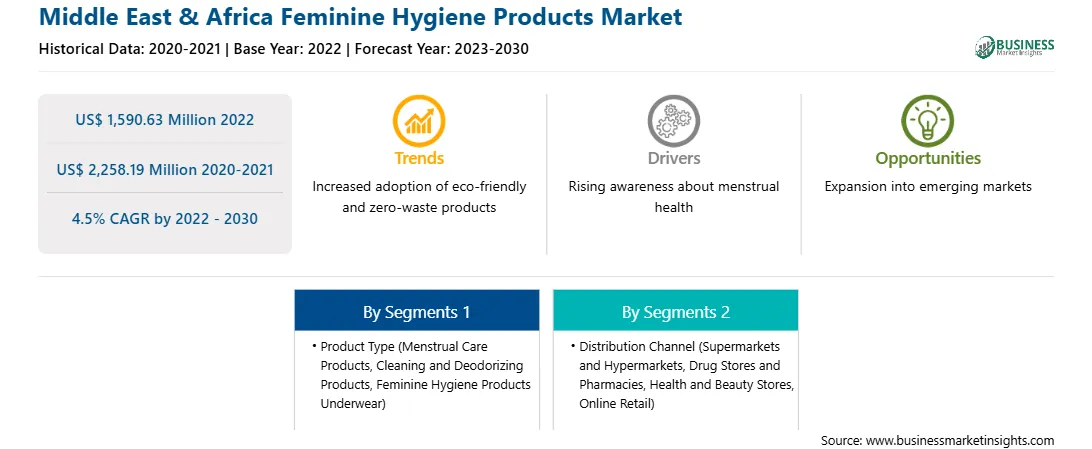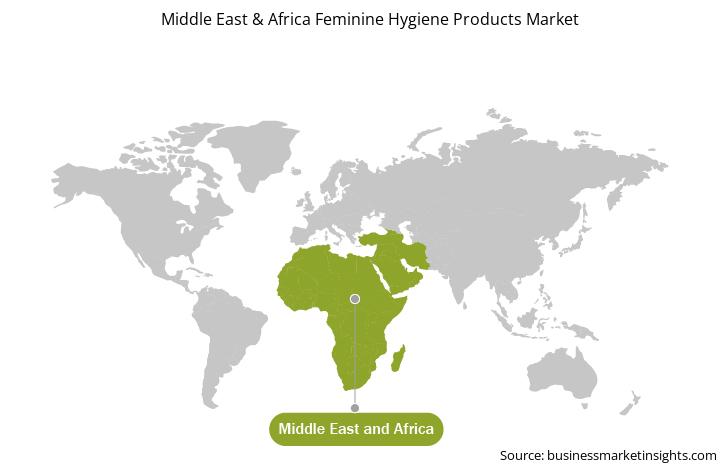Eco-friendly and reusable feminine hygiene products are becoming popular with rising sustainability concerns among consumers across the region. The non-biodegradability of female hygiene products is a major environmental concern. Thus, environmentally friendly sanitary napkins, panty liners, and tampons, among other feminine hygiene products made of natural fibers, are a viable choice. Organic cotton, jute, banana fiber, and bamboo are among the natural absorbent fibers. They are widely available and biodegradable, with a minimal carbon footprint. Using these fibers also lowers the production costs of feminine hygiene products. The absorbency and retention properties of these natural fibers make them a preferred choice over conventional options. Banana fiber, bamboo fiber, jute fiber, and a combination of cellulose-based hydrogel have a similar absorbency rate as compared to synthetic superabsorbent polymer (SAP). Similarly, in place of non-biodegradable polyethylene and polyurethane, a bio-based plastic made from starch can be utilized as a barrier sheet. A few companies that create eco-friendly products include Shethinx, Saaltco, and Wearedame. For instance, Boots sells plant-based applicator tampons that are both affordable and eco-friendly. Moreover, companies are adopting novel technologies, and launching reusable panty liners and sanitary pads, which are impermeable, chlorine-free, and reusable/washable. The launch addressed the increasing plastic population and Middle East & Africa warming caused by non-disposable tampons. Thus, the increasing adoption of reusable and eco-friendly feminine hygiene products is expected to create a new trend in the market during the forecast period.
The Middle East & Africa feminine hygiene products market is segmented into South Africa, Saudi Arabia, the UAE, and the Rest of Middle East & Africa. Increasing government emphasis on feminine healthcare, improving quality of lifestyle, and growing awareness regarding feminine hygiene are the key driving factors of the feminine hygiene products market in the region. In February 2018, Water Supply and Sanitation Collaborative Council (WSSCC), in collaboration with UN Women, implemented a joint program named Gender, Hygiene, and Sanitation in three countries in West Africa—Senegal, Niger, and Cameroon. The program was aimed at health, hygiene, and sanitation policies for women in these countries and promoting menstrual hygiene management (MHM). Also, women welfare organizations such as AFRIpads, Qrate, ZanaAfrica, Pad-Up Africa, Sanitary Aid Initiative, and Speak Up Africa are taking initiatives to offer sanitary aids and education about menstrual hygiene in rural and urban areas. AFRIpads, founded in a rural village in Uganda in 2010, manufactures reusable sanitary pads and partners with organizations such as UNICEF and Save the Children to improve African menstrual health. Also, they are creating and distributing “Girl Talk,” a comic booklet that explains menstrual periods in an engaging and accessible manner. Such initiatives by governments and organizations have contributed to the feminine hygiene products market growth in the region.
The Middle East & Africa feminine hygiene products market is segmented into product type, distribution channel, and country.
Based on product type, the Middle East & Africa feminine hygiene products market is segmented into menstrual care products, cleaning and deodorizing products, and feminine hygiene underwear. The menstrual care products segment registered the largest Middle East & Africa feminine hygiene products market share in 2022.
Based on distribution channel, the Middle East & Africa feminine hygiene products market is segmented into supermarkets and hypermarkets, drug stores and pharmacies, health and beauty stores, online retail, and others. The others segment held the largest market share in 2022.
Based on country, the Middle East & Africa feminine hygiene products market has been categorized into South Africa, Saudi Arabia, the UAE, and the Rest of Middle East & Africa. The Rest of Middle East & Africa dominated Middle East & Africa feminine hygiene products market in 2022.
Edgewell Personal Care Co, Essity AB, Kimberly-Clark Corp, Lune Group Oy Ltd, Mooncup Ltd, Ontex BV, and The Procter & Gamble Co are some of the leading companies operating in the feminine hygiene products market in the region.
Strategic insights for the Middle East & Africa Feminine Hygiene Products provides data-driven analysis of the industry landscape, including current trends, key players, and regional nuances. These insights offer actionable recommendations, enabling readers to differentiate themselves from competitors by identifying untapped segments or developing unique value propositions. Leveraging data analytics, these insights help industry players anticipate the market shifts, whether investors, manufacturers, or other stakeholders. A future-oriented perspective is essential, helping stakeholders anticipate market shifts and position themselves for long-term success in this dynamic region. Ultimately, effective strategic insights empower readers to make informed decisions that drive profitability and achieve their business objectives within the market.

| Report Attribute | Details |
|---|---|
| Market size in 2022 | US$ 1,590.63 Million |
| Market Size by 2030 | US$ 2,258.19 Million |
| Global CAGR (2022 - 2030) | 4.5% |
| Historical Data | 2020-2021 |
| Forecast period | 2023-2030 |
| Segments Covered |
By Product Type
|
| Regions and Countries Covered | Middle East and Africa
|
| Market leaders and key company profiles |
The geographic scope of the Middle East & Africa Feminine Hygiene Products refers to the specific areas in which a business operates and competes. Understanding local distinctions, such as diverse consumer preferences (e.g., demand for specific plug types or battery backup durations), varying economic conditions, and regulatory environments, is crucial for tailoring strategies to specific markets. Businesses can expand their reach by identifying underserved areas or adapting their offerings to meet local demands. A clear market focus allows for more effective resource allocation, targeted marketing campaigns, and better positioning against local competitors, ultimately driving growth in those targeted areas.

The Middle East & Africa Feminine Hygiene Products Market is valued at US$ 1,590.63 Million in 2022, it is projected to reach US$ 2,258.19 Million by 2030.
As per our report Middle East & Africa Feminine Hygiene Products Market, the market size is valued at US$ 1,590.63 Million in 2022, projecting it to reach US$ 2,258.19 Million by 2030. This translates to a CAGR of approximately 4.5% during the forecast period.
The Middle East & Africa Feminine Hygiene Products Market report typically cover these key segments-
The historic period, base year, and forecast period can vary slightly depending on the specific market research report. However, for the Middle East & Africa Feminine Hygiene Products Market report:
The Middle East & Africa Feminine Hygiene Products Market is populated by several key players, each contributing to its growth and innovation. Some of the major players include:
The Middle East & Africa Feminine Hygiene Products Market report is valuable for diverse stakeholders, including:
Essentially, anyone involved in or considering involvement in the Middle East & Africa Feminine Hygiene Products Market value chain can benefit from the information contained in a comprehensive market report.